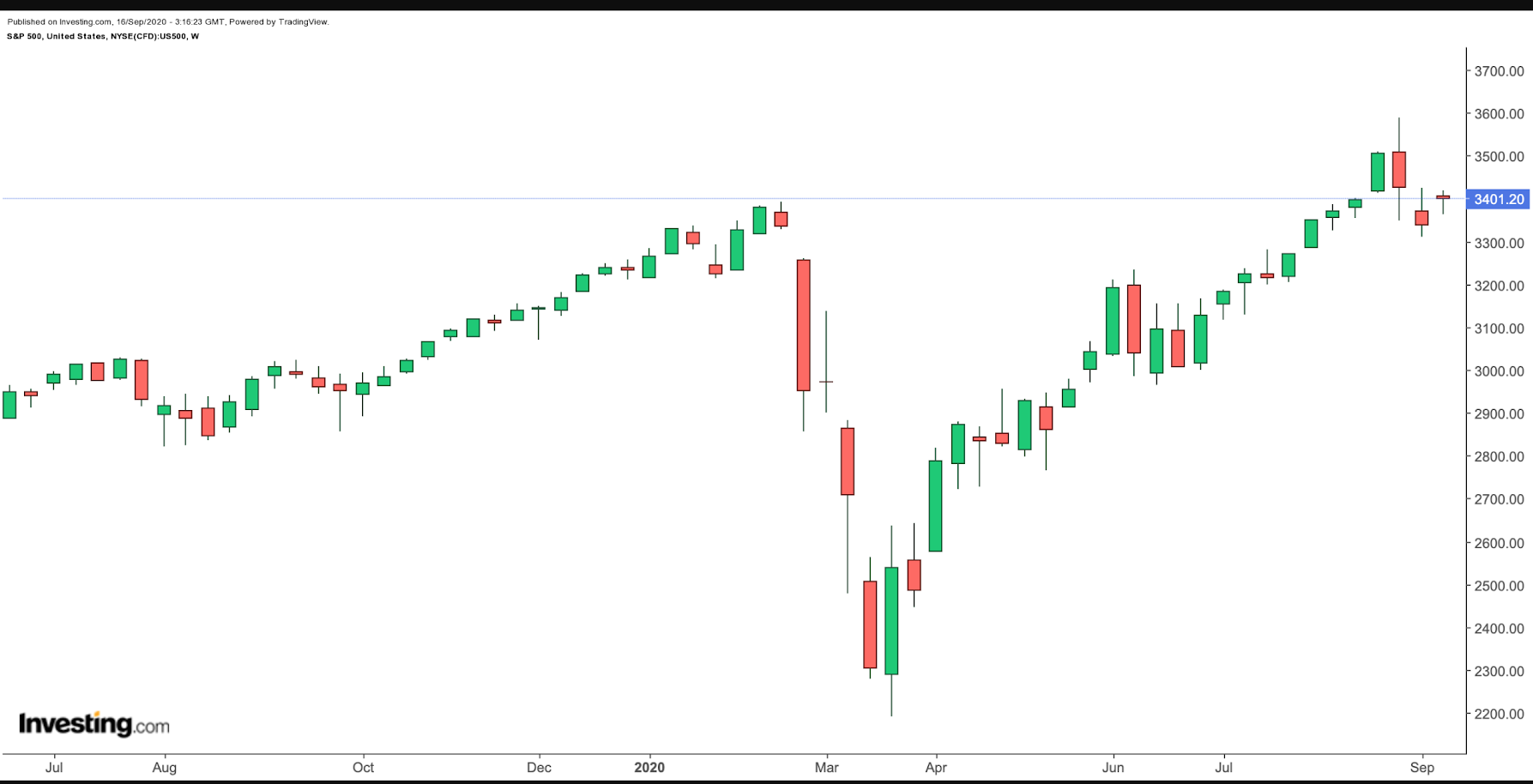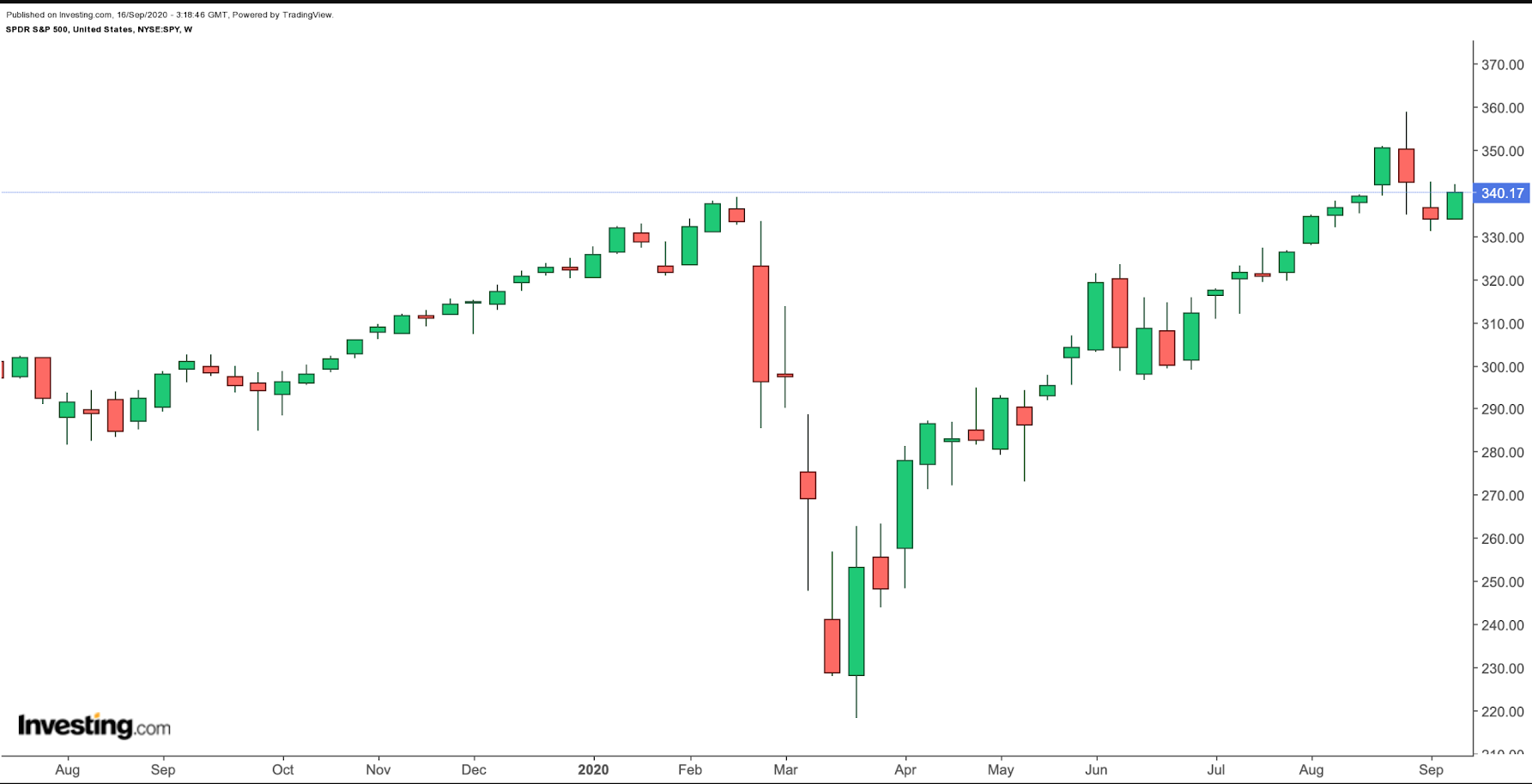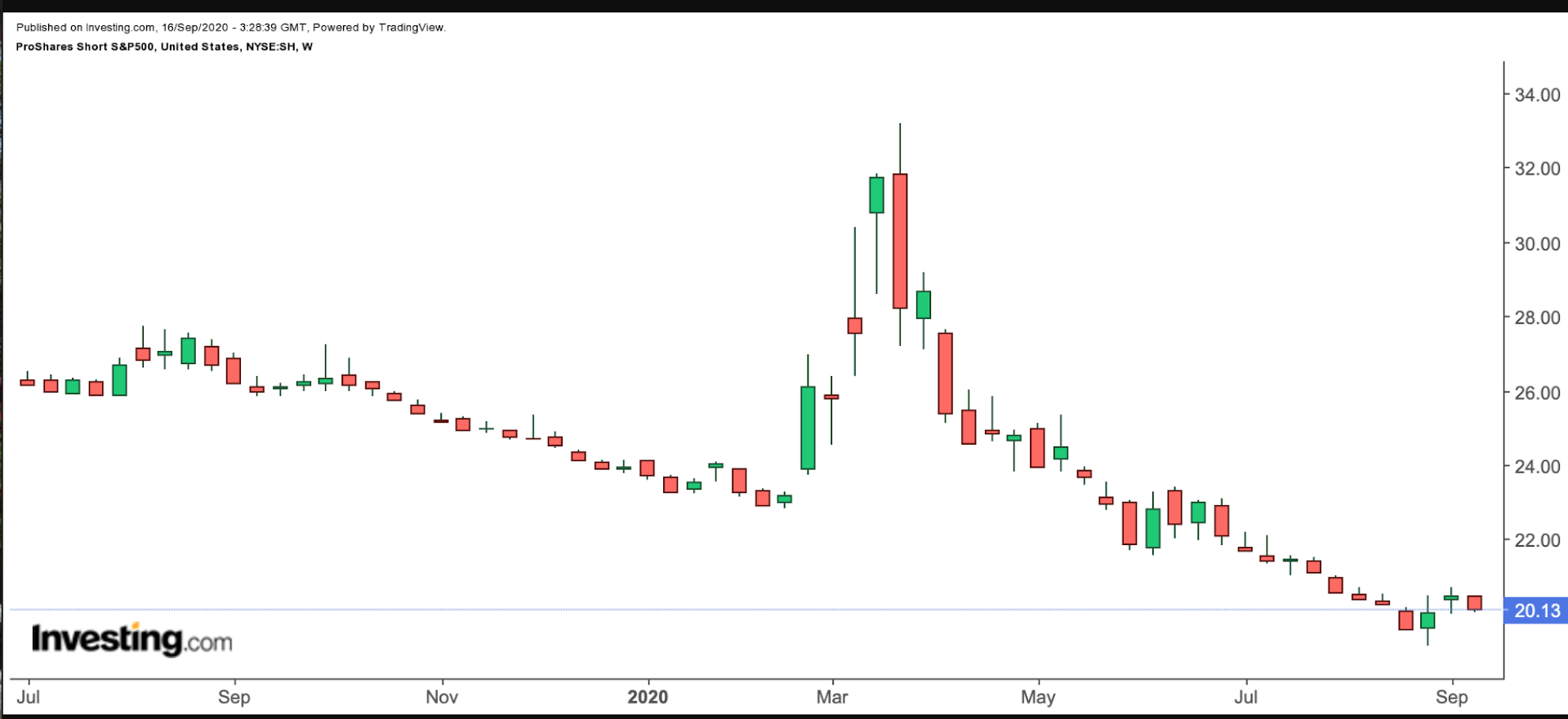The first half of September has seen market volatility return with a downward bias. In such times, investors want to know how they can protect or hedge their portfolios against a substantial hit.
Reducing Volatility Of Returns
A hedging strategy typically involves adding diverse positions to a portfolio so that the volatility of returns is reduced. A wide range of hedging tools and approaches are available.
As part of diversification, market participants can include exchange-traded funds (ETFs) that may shield them or even enable them to profit when markets decline. Today, our focus will be on the S&P 500 index, which has risen around 13% over the past 12 months.

S&P 500 Weekly
Earlier in July, we discussed how investors could consider buying the SPDR S&P 500 (NYSE:SPY) to participate in the index’s moves higher. SPY, which currently hovers at $340, is also up about 13% over the past year.

SPY Weekly
Below, we’ll address two ETFs that may help calm investors who fear risks in broader markets will be accelerating in the short-run.
1. Amplify BlackSwan Growth & Treasury Core ETF
- Current Price: $32
- 52 Week Range: $26.39 – $33.24
- Dividend Yield: 0.36%
- Expense Ratio: 0.49% per year, or $49 on a $10,000 investment
The BlackSwan ETF (NYSE:SWAN) tracks the S-Network BlackSwan Core Total Return index.
SWAN provides uncapped exposure to the S&P 500 index while hedging to avoid significant losses. Currently, around 88% of the fund is invested in US Treasury securities with different maturities. The rest of the holdings are in-the-money (ITM) SPY LEAP call options with two different expiration dates.
We discussed call options in the context of covered call ETFs. Now comes another dimension: LEAP options. LEAP stands for “Long-Term Equity Anticipation.”
Investors who believe in the long-run growth potential of underlying assets, such as SPY, could consider using LEAP options, which are long-dated, usually one to two years till expiration.
ITM means the strike price of the option is already below the current market price. As a result, investors can get more “index-like” returns.
Because the exposure to equities comes through holding options, the fund has limited downside risk, capped by the amount paid for those options’ premiums. For SWAN, it is around 10% of the total capital invested. Put another way, in case of a “black swan” event, which would cause the S&P 500 index to tank, only about 10% of the fund would be at risk.
The two sets of LEAP options in SWAN have different expiry dates and strike prices. They are:
- Long SPDR S&P Call December 2020 expiry with 283 strike (5.77%)
- Long SPDR S&P Call June 2021 expiry with 265 strike (6.17%)
Each of these options is rebalanced once a year. So far in the year, SWAN is up over 13.5%.

SWAN Weekly
This ETF does not provide protection for current holdings in a portfolio. Thus, SWAN is more appropriate for investors who are planning to buy SPY soon but are concerned about downside risks at present. They can, for example, buy the dips in SWAN to participate in a longer-term up move in SPY.
Furthermore, this strategy can quite easily be replicated by those who are experienced with options and would like to start building positions. In such a case, 70-delta LEAP call options could be appropriate. Those investors would participate in the upside of the S&P 500 (but not by 100%) while limiting their downside significantly.
2. ProShares Short S&P 500
- Current Price: $20.13
- 52 Week Range: $19.16-$33.19
- Dividend Yield: 1.1%
- Expense Ratio: 0.89%
The second ETF comes from the world of inverse exchange-traded funds. We’d have to emphasize that while inverse funds can be effective hedging tools, they are more appropriate for short-term trading as opposed to long-term investing. Therefore, traders would need to monitor portfolios carefully and possibly rebalance positions to maintain the hedge.
The ProShares Short S&P500 (NYSE:SH) seeks daily investment results that correspond to the inverse (-1x) of the daily performance of the S&P 500 index.

SH Weekly
Due to the compounding of daily returns, any holding period for longer could easily result in returns that significantly differ from the target. Therefore, for holding periods longer than a trading day, SH may not necessarily move inversely to the S&P 500.
To achieve the desired inverse effect on a daily basis, fund managers hold derivative products–mostly futures and swap agreements. As a result, over longer periods, time decay and the negative rebalancing effect come into play.
So far in the year, SH is down about 16%. On the other hand, the S&P 500 index climbed around 5%. Similarly, over the past 12 months, SH dropped about 22.5%, while the S&P 500 increased around 13%. The difference in (inverse) returns is a solid reminder of the daily hedging purpose of the fund.
For short-term objectives, bear funds can be valuable, especially for experienced traders. Long-term retail investors may want to learn more about how inverse funds work before jumping the gun.
Bottom Line
Today we discussed two exchange-traded funds that utilize derivative products, including futures, options and swaps. Before investing, it is important to have a solid understanding of exactly how these products work.
Those who are more experienced with options could also consider devising their hedging strategies using options on the SPDR S&P 500 ETF.
For example, investors who already own SPY may consider using an at-the-money (ATM) or a slightly ITM covered call strategy with an approximately one-month time horizon, like an October 16 expiry. Such a covered call position offer some downside protection and decrease portfolio volatility, allowing for participation in a potential up move.
However, if SPY declines substantially over the course of the month, the covered call may not be able to provide sufficient downside protection. Investors would need to monitor their positions closely and take further action if appropriate.
Another alternative could be purchasing protective puts that offer downside protection from the chosen strike price all the way down to zero. It is important to monitor the effect of volatility levels on option prices. We’d typically avoid buying puts outright when volatility is too high, since they can be expensive during these periods.
The last strategy to consider: bearish vertical put spreads in SPY. Investors need to specify how much downside protection to have, which would influence the amount they pay. Put spreads can help eliminate extra for the volatility component in the protection. However, such spreads do not provide as much protection as protective puts.
Any of these listed strategies could be applicable for not only SPY, but also other stocks and ETFs in a portfolio.


